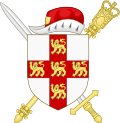The City of York is a unitary authority area with city status in the ceremonial county of North Yorkshire, England. [6]
Contents
The district's main settlement is York, and its coverage extends to the town of Haxby and the villages of Earswick, Upper Poppleton, Nether Poppleton, Copmanthorpe, Bishopthorpe, Dunnington, Stockton on the Forest, Rufforth, Askham Bryan and Askham Richard, among other villages and hamlets. The district had a population of 202,800 in the 2021 Census [7] [8] The City of York is administered by the City of York Council based in The Guildhall. [9]





